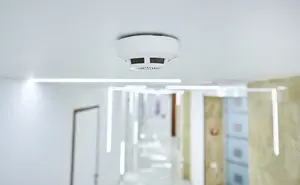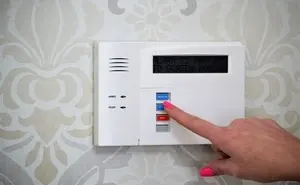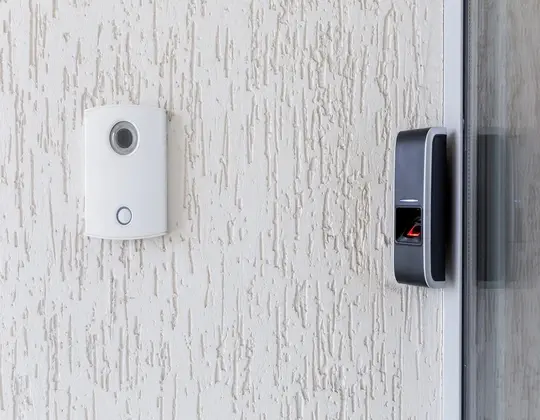Door & window sensors are vital components of the home security system. These sensors provide an added layer of protection by detecting unauthorized entry into a property. Door sensors are typically installed on the frame or jamb of a door, while window sensors are affixed to the window frame. When the door or window is opened, the sensor sends a signal to the main control panel, which triggers the alarm system. This immediate notification allows homeowners to take swift action, such as contacting authorities or securing their property. Door and window sensors come in various types, ranging from magnetic sensors to contact sensors, providing versatile options to suit different security needs.
Door and window sensors can be integrated with other components of a home security system, such as motion sensors, surveillance cameras, and smart home technology. This integration enables homeowners to create a comprehensive and customized security solution that meets their specific needs. For example, when combined with motion sensors, the door and window sensors can create a "perimeter" of protection, detecting any movement around the house. Integration with smart home technology allows homeowners to remotely monitor the status of their doors and windows through a mobile app, giving them the ability to arm or disarm the system at any time, no matter where they are.
How do Door and window Sensors Work?
Door and window sensors are a key component of home security systems. They help protect your property by detecting unauthorized entry and triggering an alarm.
- Magnet and Sensor Alignment:
In magnetic sensors, the magnet is usually installed on the moving part of the door or window, while the sensor is placed on the frame. When the magnet and sensor align, a circuit is completed, indicating that the door or window is closed and secure. If the circuit is disrupted, it indicates that the door or window has been opened.
- Reed Switch Technology:
One of the most common types of magnetic sensors used is the reed switch. This switch contains two metal reeds that are encased in a glass tube filled with inert gas. When a magnet is brought near the reed switch, the magnetic field causes the reeds to attract and make contact, closing the circuit. When the magnet moves away, the reeds separate, breaking the circuit and triggering an alarm.
- Mechanical Sensors:
Mechanical sensors operate on a slightly different principle. These sensors have a spring-loaded design that is triggered when pressure is released from the door or window. When the door or window is in its normal, closed position, the spring remains compressed, and no alarm is triggered. However, when the door or window is opened, the spring expands, causing a switch to activate and initiating the alarm.
- Wired and Wireless Options:
Door and window sensors can be either wired or wireless, depending on the type of security system you have. Wired sensors are directly connected to the security control panel through electrical wires. On the other hand, wireless sensors communicate with the control panel via radio frequency signals.
- Integration with Security Systems:
Door and window sensors are an integral part of a larger home security system. When a sensor is triggered, it sends a signal to the control panel, which then activates the alarm, alerting you or your security monitoring service of a potential break-in. Some sensors can also be integrated with smartphone apps, allowing you to receive real-time notifications on your mobile device.
Benefits of Door & Window Sensors
 Entry Detection
Entry Detection Automatic Alerts
Automatic Alerts Versatility
VersatilityYour home has different needs
Door and window Sensors can be customized to meet specific needs. Different security systems offer a variety of options, including pet-friendly sensors that can differentiate between the movements of a pet and a potential intruder. This feature ensures that homeowners with pets can coexist with their security systems without compromising their furry friends' freedom of movement. They provide protection tailored to the unique needs of a home, whether it is large or small, permanent or temporary. With their versatility and ability to integrate seamlessly into any living space, these sensors offer homeowners the peace of mind they deserve.


Keep track of who enters your home remotely
Door and window Sensors also offer convenience and control. By integrating these sensors into your home security system, you can automate various tasks based on the status of doors and windows. For example, you can program your system to turn on lights or adjust the temperature when a door is opened, or to arm the security system when a window is left open. This level of customization allows you to create a smart home that suits your lifestyle and enhances your overall comfort and safety. Whether you're looking to enhance the security of your home or simply want to have better control over who enters your property, Door, and window Sensors offer an effective and convenient way to achieve peace of mind.
Door & Window Sensors Additional Features




FAQ
Q: What are door and window sensors?
Q: How do door and window sensors work?
A: Door and window sensors typically consist of a two-piece system, including a sensor and a magnet. When the door or window is closed, the magnet is near the sensor, creating a closed circuit. When the door or window is opened, this circuit is broken, triggering an alarm or sending a notification to the security system.
Q: How are door and window sensors installed?
A: Door and window sensors are usually easy to install. The sensor is typically attached to the door or window frame, while the magnet is placed on the door or window itself. They can be mounted using adhesive tape, screws, or other fasteners.
Q: Can door and window sensors be used with existing security systems?
Q: Can door and window sensors differentiate between normal and forced entry?
A: Door and window sensors are primarily designed to detect any opening or closing of doors and windows, regardless of the force used. However, some advanced sensors may have features to distinguish between normal activity (such as opening a door using a key) and forced entry, providing an extra layer of security and reducing false alarms.
Q: Are door and window sensors weather-resistant?
A: Many door and window sensors are designed to be weather-resistant, allowing them to withstand exposure to rain, snow, and extreme temperatures.
Q: Can door and window sensors be used for other purposes than security?
A: While door and window sensors are primarily used for security purposes, they can also be utilized in other applications.

